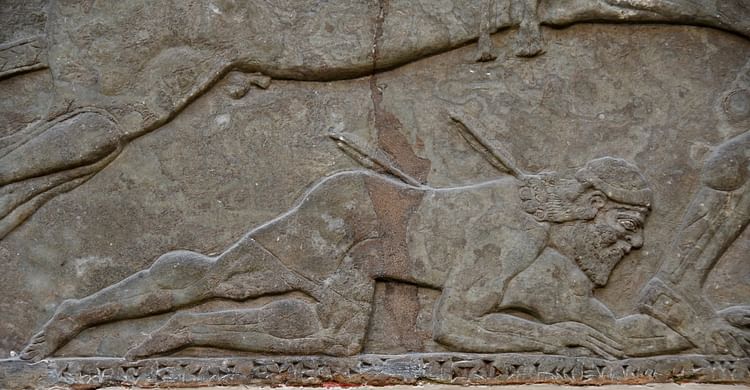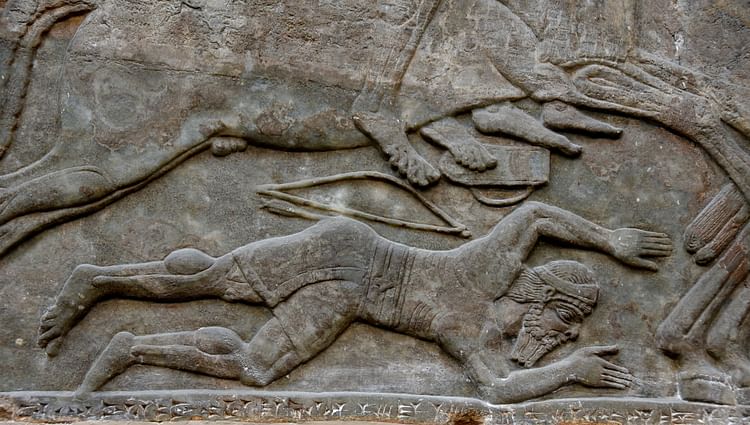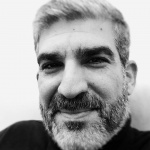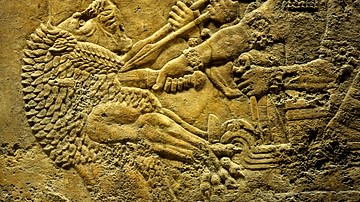The Mighty King
600 of their warriors I put to the sword and decapitated; 400 I took alive; 3,000 captives I brought forth; I took possession of the city for myself: the living soldiers, and heads to the city of Amidi the royal city, I sent.
(Annals of Assur-Nasir-Pal II 3.107).

This is how Ashurnasirpal II (r. 884-859 BCE) recorded the way he had dealt with his enemies during one of his military campaigns. Most of the time, the overwhelming Assyrian Imperial army was led on the battlefield by an apparently heartless and harsh Assyrian King. The destiny of the defeated enemy, revolt, or turmoil, whether kings, princes, officers, soldiers, poor lay people, or children, should be an ever-lasting memorable event, a fatal lesson taught to anyone thinking, or may be thinking, of doing the same, threatening the crown and destabilising the Assyrian Empire. This propaganda of terror had to be documented and delivered to a wide-ranging audience, internal and external. Stelae, monuments, stones, and clay prisms were the media used to “broadcast” the King's achievements.
How about the King's court, is it one of the key players? Every now and then, foreign rulers, high officials, ambassadors, messengers, and tribute bearers visit the King. Ashurnasirpal II had decorated the walls of his North-West Palace at the heart of the Assyrian Empire, Nimrud, with approximately 2-meter high alabaster bas-reliefs, depicting various scenes, like a movie in stone. The protagonist of the play, the title role, and the award winner, undoubtedly, was the King himself.
But, how about others, the supporting actors and actresses? It is not a monodrama after all! The throne room, Room B, of the North-West Palace was lined with war scenes of the so-called “victors and the vanquished” theme, depicting Ashurnasirpal II engaging in various military activities and charging his enemies. This room was not chosen haphazardly, it is the core of the King's court! All have to see and absorb the message.
Despite being out of context in Room 7 (Assyria, Nimrud) of the British Museum, these reliefs undoubtedly make a lasting impression on the museum's visitors, as they have done in the past. I will concentrate on certain features and details, rather than the King himself, to demonstrate; these details are usually overlooked by the visitors. These wall panels were excavated by Sir Henry Layard in 1846 while unearthing the North-West Palace at Nimrud, Iraq. They reached the British Museum in 1849. I put an elaborate description below each image.
The battlefield environment

Neo-Assyrian Period, 865-860 BCE. Panel 18 (top) of Room B, the North-Palace Palace, Nimrud, modern-day Iraq.
An attack on a strongly walled city. The defenders, within crenellated turrets, are shooting arrows at the Assyrians. The battering ram of the Assyrian siege engine has repeatedly hit and finally broken the city's wall; bricks are falling. An Assyrian archer, standing within a wooden tower is shooting arrows at the enemy, within a short distance from the turrets, and he is guarded by a shield held by another soldier. Ashurnasirpal II stands behind the siege engine and shoots arrows at the foes. On his left side, a soldier holds a long spear and a shield to protect the King from the enemy's arrows. Behind the King, another soldier holds a shield, arrows, and a quiver of arrows. A royal attendant holding a bow, quiver, and mace stands behind the attackers. The scene is so vivid and so dynamic, as if it is an animated GIF image or a brief video clip.

Neo-Assyrian Period, 865-860 BCE. Detail of Panel 4 (bottom), Room B, the North-Palace Palace, Nimrud, modern-day Iraq.
This bearded figure wearing a diadem with long lappets, elaborate costume, bracelet, and a long sword is not the King; he is the Crown Prince, Shalmaneser III, Ashurnasirpal II's son! Shalmaneser draws back the bowstring and is ready to shoot the enemy. Besides him, there is a soldier, holding a shield and a dagger to protect him.
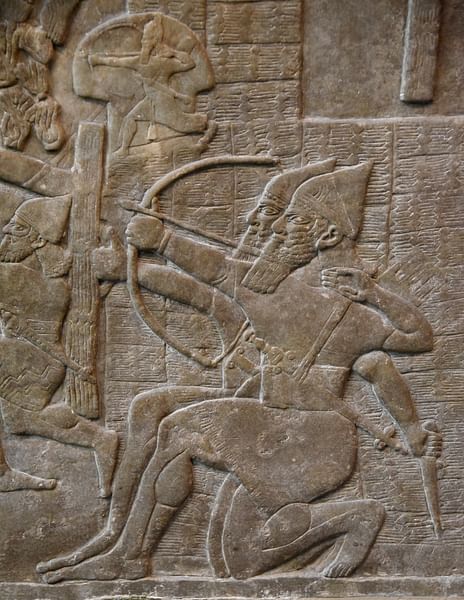
Neo-Assyrian Period, 865-860 BCE. Detail of Panel 4 (bottom), Room B, the North-Palace Palace, Nimrud, modern-day Iraq.
An Assyrian archer is kneeling and has drawn his bowstring back to shoot. His fellow also kneels and holds a dagger and a shield to protect him from enemy attacks. Above them and on the side of the siege engine, there appears to be an iron plate depicting a warrior wearing a horned helmet and shooting an arrow; this is a god, who stands beside the Assyrians to win the battle. Figures of deities commonly accompany armies. If you don't thoroughly scrutinize the whole panel, you will definitely miss this wonderful “evidence”.
Attack!
Neo-Assyrian Period, 865-860 BCE. Detail of Panel 5 (bottom), Room B, the North-Palace Palace, Nimrud, modern-day Iraq.
The assault has begun and the attacking wave is overwhelming. A ladder has been lent on the city's wall. An Assyrian soldier climbs up the ladder and holds a shield for protection. Another soldier follows him. An Assyrian soldier stands between the ladder and the city wall and is holding a shield protecting another soldier who seems to crawl through a tunnel or a defect in the city's wall. Some of the defenders have been shot and killed and are falling from the turrets. The large shield on the left is held by an Assyrian soldier to protect Ashurnasirpal II, who is aiming at the turrets with a bow and arrow (not shown here).

Neo-Assyrian Period, 865-860 BCE. Detail of Panel 5 (bottom), Room B, the North-Palace Palace, Nimrud, modern-day Iraq.
The mid-upper part of this panel was lost but the remaining shows that an enemy soldier has lowered a long iron chain to divert the battering ram away from the city's wall. Meanwhile and to counteract this, two Assyrian soldiers are using hooks to pull down the chain. At the left upper turret, an enemy archer is aiming at those soldiers with his bow and arrow. At the upper right corner, the enemy has thrown torches on the siege engine. At the middle, an enemy soldier has fallen from the turret after being killed (shot by an arrow?). At the lower part near the river, two Assyrian soldiers are making a hole in the city's wall and the main tower, by removing the bricks/stones.
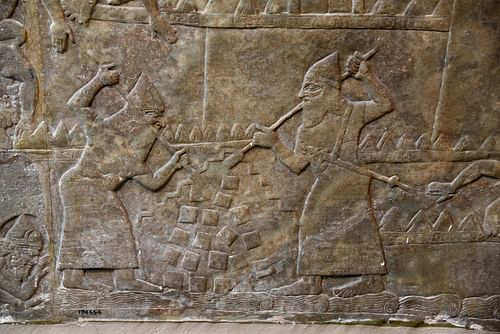
Neo-Assyrian Period, 865-860 BCE. Detail of Panel 4 (bottom), Room B, the North-Palace Palace, Nimrud, modern-day Iraq.
Two Assyrian soldiers use iron crowbars to chisel out bricks from the city's wall. This will create a hole through which the Assyrian soldiers enter the city.
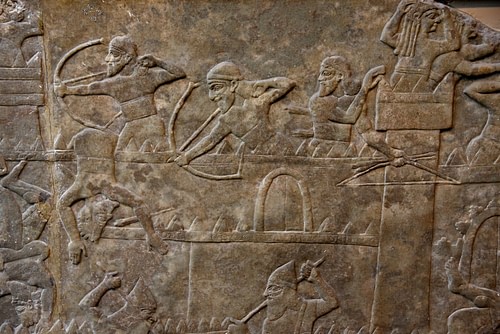
Neo-Assyrian Period, 865-860 BCE. Detail of Panel 4 (bottom), Room B, the North-Palace Palace, Nimrud, modern-day Iraq.
The Assyrian army attacks from all directions. The defenders within the turrets are perplexed and cannot stop the attacking wave. The woman on the long tower seems to lament.
No Escape
Neo-Assyrian Period, 865-860 BCE. Detail of Panel 11 (top), Room B, the North-Palace Palace, Nimrud, modern-day Iraq.
A foe has fallen on the ground beneath one of the horses of an Assyrian war chariot. He was shot by two arrows in the back, which have penetrated deeply, up to the feathers. It looks like the man was trying to escape after his city was defeated and captured by the Assyrian army. The man's posture suggests that he is still alive but moribund. There are no weapons around him. The Assyrian sculptor seems to have exaggerated the foe's musculature; this would convey an image of a powerful and dangerous rival, which in turn reflects the Assyrian bravery.
Neo-Assyrian Period, 865-860 BCE. Detail of Panel 9 (top), Room B, the North-Palace Palace, Nimrud, modern-day Iraq.
An enemy has fallen beneath an Assyrian horse. He was either shot by one arrow in the lower back or that arrow was the only and final ammo he had. The quiver beside him is empty and the bow is on the ground. The man was out of ammo and tried to escape. He appears dead or is dying.

Neo-Assyrian Period, 865-860 BCE. Detail of Panel 9 (top), Room B, the North-Palace Palace, Nimrud, modern-day Iraq.
This decapitated foe has fallen on the ground after being shot by two arrows in his back. There is an empty quiver and a bow beside him; another one who has failed escape after running out of arrows. Assyrian cavalry is passing over him.

Neo-Assyrian Period, 865-860 BCE. Detail of Panel 9 (top), Room B, the North-Palace Palace, Nimrud, modern-day Iraq.
On the right, an enemy soldier tries to pull his fellow soldier away in order to escape from an attacking, furious, and blood-thirsty Assyrian soldier; both of the retreating men appear unarmed.

Neo-Assyrian Period, 865-860 BCE. Detail of Panel 9 (top), Room B, the North-Palace Palace, Nimrud, modern-day Iraq.
Two enemy soldiers have escaped and tried desperately to hide among trees near their captured city. There is a river depicted in the lower part of the panel. Two Assyrian soldiers have seen their enemy and tried to seize their foes. On the left, the Assyrian soldier faces his foe and holds the head of the enemy with one hand and appears to thrust his dagger into the enemy's chest using the right hand. The collapsed enemy grips the Assyrian soldier's left arm and the attacking dagger. On the right, the enemy soldier tries to run away and turns his head towards his killer but the Assyrian soldier seems to push him using his shield and is about to stab him. What a dynamic and live broadcast!

Neo-Assyrian Period, 865-860 BCE. Detail of Panel 8 (top), Room B, the North-Palace Palace, Nimrud, modern-day Iraq.
A desperate enemy soldier is semi-kneeling on the ground. An Assyrian soldier with a terrorizing look grips that man's scalp hair and slaughters him. There is a bow and a quiver full of arrows on the ground.
A Free Meal for Vultures
Flocks of vultures were commonly depicted on Mesopotamian stelae and stone monuments, and wall reliefs of the North-West Palace were no exempt. Vultures attack dying or dead enemy soldiers on the battlefield. Predator birds still live in modern-day Iraq.
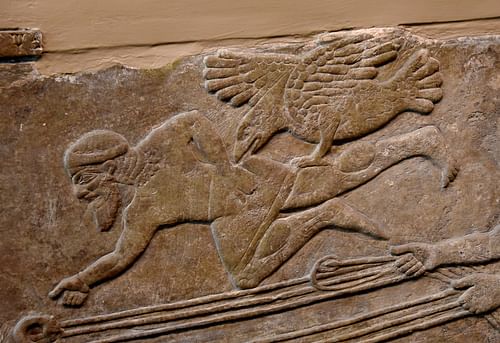
Neo-Assyrian Period, 865-860 BCE. Detail of Panel 3 (bottom), Room B, the North-Palace Palace, Nimrud, modern-day Iraq.
A vulture (or a predatory bird) plucks at a body of a dead enemy soldier. The vulture's wings, beak, and talons reflect an attacking posture.

Neo-Assyrian Period, 865-860 BCE. Detail of Panel 11 (top), Room B, the North-Palace Palace, Nimrud, modern-day Iraq.
The body gesture of this enemy soldier suggests that he is already dead; a vulture (or a predatory bird) pecks out his eye.
It's Time for Decapitation
Decapitation was commonly depicted on Assyrian wall reliefs. What does this reflect? Possibly, a victorious soldier who really hates his enemy and who feels an extreme pleasure while cutting the throat of his foe. In addition, documenting this event visually is a way of broadcasting victory and is a threat message to potential enemies.

Neo-Assyrian Period, 865-860 BCE. Detail of Panel 6 (top), Room B, the North-Palace Palace, Nimrud, modern-day Iraq.
Two Assyrian soldiers hold the decapitated heads of their enemies before musicians (two lyre players and one tambourine player); they are celebrating their victory immediately on the battlefield. These vivid and graphic images directly reflect what's happening in the triumphal environment; the voice of agony, the sight of death, and the odour of blood are mixed with music.

Neo-Assyrian Period, 865-860 BCE. Detail of Panel 6 (top), Room B, the North-Palace Palace, Nimrud, modern-day Iraq.
Those Assyrian soldiers are perhaps playing catch or, less likely, counting and stacking the decapitated heads of their enemies.
THE Finale
Neo-Assyrian Period, 865-860 BCE. Detail of Panel 5 (bottom), Room B, the North-Palace Palace, Nimrud, modern-day Iraq.
Two women and a child are walking away and are led by an Assyrian soldier to join a procession of prisoners. Civilians were either taken prisoner (and they might engage in construction work) or simply deported to live in other areas of the Assyrian Empire; they were unlikely to be killed.
Neo-Assyrian Period, 865-860 BCE. Panel 17 (bottom), Room B, the North-Palace Palace, Nimrud, modern-day Iraq.
This complete panel documents and broadcasts the typical tell-tale review of the prisoners and booty theme. Ashurnasirpal II stands (depicted on the panel on the left, not shown here in this image) to receive the booty and review the prisoners of war. The latter group cannot access the sacred figure of the King; they require an intermediary, as in all such Assyrian events. On the left, two bearded Assyrian officials are accompanied by two beardless attendants of the King (all have their swords hanging on their side), approaching the King in great dignity. Behind them, there is a person, distinguished from all other kinds of staff, who brings up the rear of the officials. He is recognizable by his humble page-boy hair style. The head of the group of prisoners is behind this man; an Assyrian soldier grasps his head in a humiliating gesture. Three more prisoners follow and another Assyrian soldier holding a bow and a sword completes the row and pushes the procession forward in disgrace and dishonour. Every now and again, a new element relieves the monotony. That page-boy haired man looks at his superior (not shown here), thus scrutinizing the procession, and therefore putting the King in context, so as not to miss even the slightest gesture. His left arm is raised to indicate another group to come forward. The booty is depicted on the upper part of the panel, in mid-air; cauldrons and ivory tusks were mentioned in the list of booty.
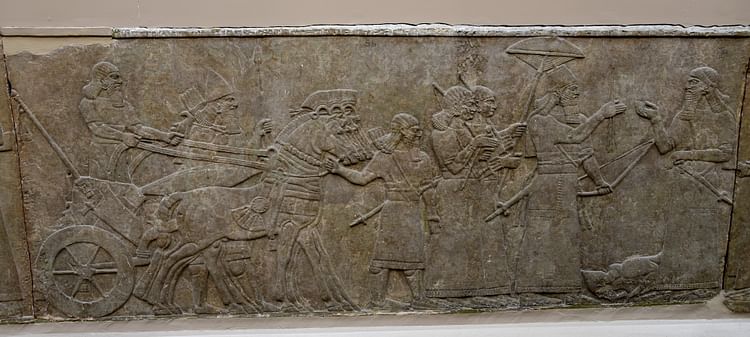
Neo-Assyrian Period, 865-860 BCE. Panel 17 (bottom), Room B, the North-Palace Palace, Nimrud, modern-day Iraq.
Concluding with a final triumph scene; the battle has ended and the Assyrians got a landslide victory. Ashurnasirpal II, after dismounting from the royal chariot, stands majestically under a parasol held by an attendant. The King wears his elegant royal costume and accessories well as a full set of weaponry. The King holds a bow and arrows; the victorious warrior. A figure greets the King in close proximity, almost touching him; he is recognizable by his long sword hanging by his side and the long curly beard. This denotes a person of the highest rank. This is “Turtanu” in Assyrian, the Chief-in-Command of the King and second in command of the whole Assyrian Empire. A soldier bows before the King, almost kissing his sandals; this is not a compelled enemy, but an Assyrian soldier who has probably distinguished himself in the fighting. Behind the King, stand his royal attendants and bodyguards. The king's chariot and the horses were exquisitely carved and the harness was depicted in a marvellous way; horses with feathered crowns were royal. The King is about to review a procession of courtiers and prisoners of war.
I had a Nikon D610 camera at that time. I spent about an hour, taking approximately 1000 zoomed-in images of the above reliefs. After I shot the pictures, I stepped backwards and observed visitors of the British Museum when they were passing through Room 7 on the Ground Floor. The above reliefs were placed on a single long wall and were arranged in two horizontal and parallel rows. An average of “20 seconds” those visitors had spent to see this short but detailed film in stone. Finally, I interrupted a tour guide (of course in a polite way) leading a large group from South-East Asia and asked him what his group has learned? All of them said that they have enjoyed these panels. I asked his permission to show them, briefly, some important details, such as the images above; they were very impressed and started to take detailed images of the reliefs! I did not include many wonderful zoomed-in images, because I cannot put all details in this article.
Yes, it is understandable that when you visit a great museum, such as the British Museum, you will be in a hurry! But, please spend some time at some points, and scrutinize rather than just passing by. I hope that I was successful in conveying this wonderful but graphic Assyrian art from my country, Iraq, currently housed in the British Museum. Viva Mesopotamia!
This article was written in memory of war victims all over the World; their spirits still linger among us, but do they watch us?!
We are all damaged goods. We mourn when we are victims and rejoice at our enemies' misery. We pray for the victory of our fighters and the demise of the enemies. We don't do anything in between. No one talks to anyone. We just shoot or cry.
Sam Wazan, “Trapped in Four Square Miles”.


